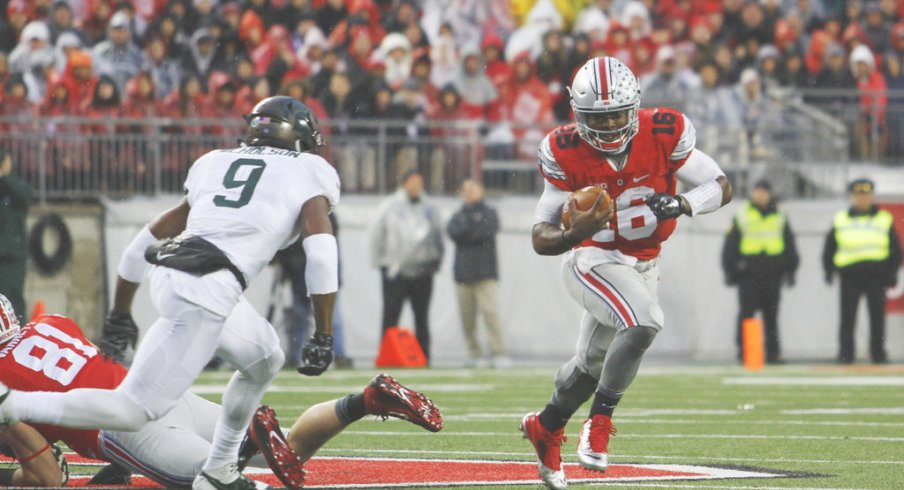As soon as Michael Geiger's game-winning field goal split the uprights in the north end of Ohio Stadium, blame for the Buckeyes' first loss in 24 contests was assigned to any and everyone in sight.
The weather had been horrible. There had been too many mental errors. The team wasn't focused. The play-calling was awful. Not only did the internet declare that every OSU coordinator deserve to be fired, some flame-throwing fans felt this performance meant Urban Meyer's time in Columbus was up as well.
But when taking a step back and reassessing the Buckeyes' performance, it's hard to place much blame for the loss on the shoulders of the OSU defense. Though they were facing a pair of backup quarterbacks, they still only allowed 17 points and 294 yards to a top-ten team with only one play, a 36-yard completion to the big ten's top receiver, Aaron Burbridge, tallying over 20 yards.
The Silver Bullets truly suffered 'death by a thousand cuts' on that cold and rainy afternoon, spending 20 of the game's final 30 minutes on the field. The unit was worn down and frustrated after largely holding the Spartan offense at bay while their teammates on the offensive side of the ball only registered two first downs in the second half.
To understand why the Buckeye offense failed so mightily on this day, we can't just look in one direction, as countless factors played into this performance. The play-calling seems to be the most topic amongst fans and even certain players, and yes, there were certainly some questionable decisions made in this department.
The Spartans didn't do much differently with their scheme on this day, showing many of the same aggressive tendencies that they have for years under head coach Mark Dantonio. When faced with a critical 3rd-and-3 on their second possession, the Spartans lined up with four down-linemen and two linebackers, giving the Buckeyes enough blockers with tight end Nick Vannett to match up.
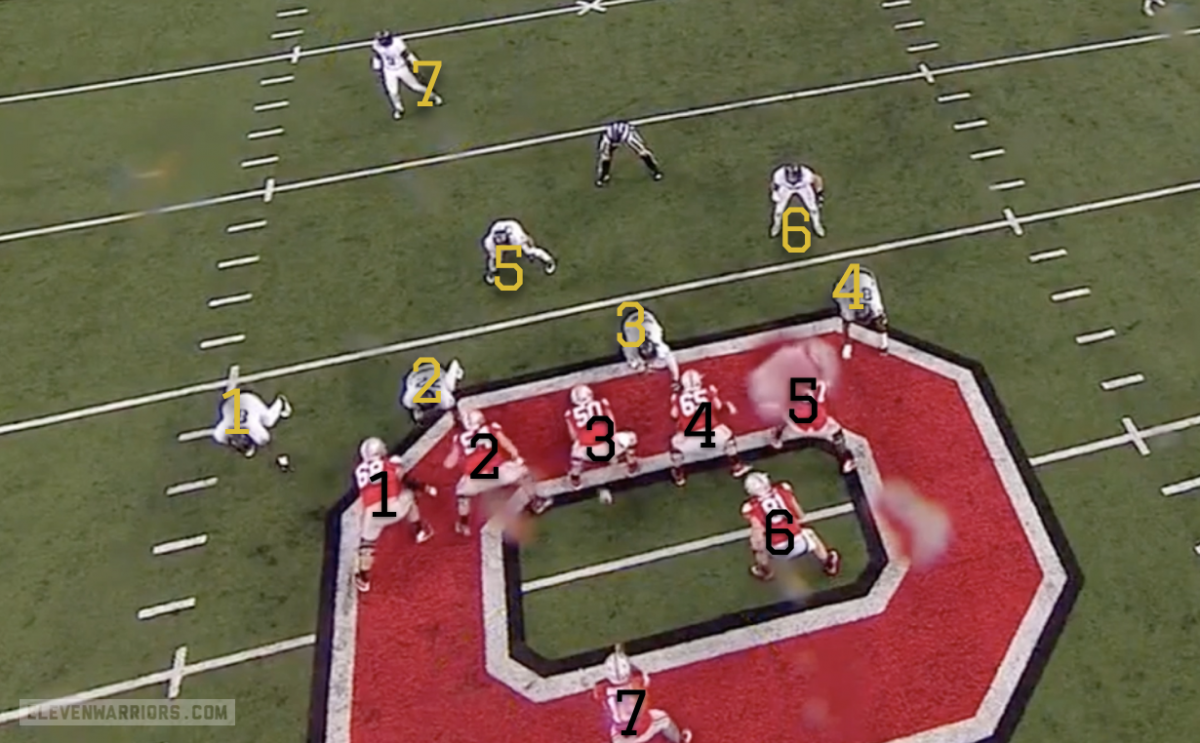
As the Buckeyes called for a 'split-zone' run with quarterback J.T. Barrett acting as the ball-carrier behind tight end Nick Vannett, the OSU front was able to get their hands on every defender in the box. However, safety Montae Nicholson flew up almost immediately to make a big tackle, a tendency of MSU defenders for years, and one that greatly slowed the OSU running game in the 2013 Big Ten championship game.

Though he had lined up ten yards deep, Nicholson may as well have been considered a box defender, given what they'd shown on film. As soon as Vannett showed that he was blocking, the safety's role in the MSU scheme is to become another linebacker against the run, and OSU played right into their hands.
The questionable tactics continued in the passing game as well. As many predicted after struggling in pass protection against Illinois, the Buckeyes regularly rolled Barrett out to his left, taking pressure off right tackle Chase Farris. By doing so though, they often rolled the QB right into the waiting arms of the best Spartan defender, end Shilique Calhoun. Left tackle Taylor Decker does a good job staying in front of the defender, but once Barrett decides to tuck the ball and run there is nowhere for him to go.

This was another avoidable situation, as Calhoun lined up to the wide side of the field all day, which in this case was to the left, while Farris was lined up against run-stuffing end Lawrence Thomas on the right. The Buckeyes easily could've let Barrett throw from the pocket, not only knowing their best pass protector was on Calhoun, but also attacking the secondary with the full width of the field instead of cutting it in half.
The Buckeyes were able to pick up their longest gain of the day this way, a simple drop-back with horizontal crossing routes coming from the 'levels' concept. Jalin Marshall was able to separate from the trailing linebacker who couldn't adjust to his speed coming across the zone, leading to a 16-yard pickup.

However the Buckeye offense didn't seem to call for these horizontal crossing patterns much afterward, instead looking to get the ball outside quickly on screens and short hitches, some of which were inaccurate due to the length of the throw in those elements.
But as difficult as it may be to admit, the Michigan State defensive front simply out-played their opponents, consistently making play after play and bottling up any potential big plays before they could take flight.
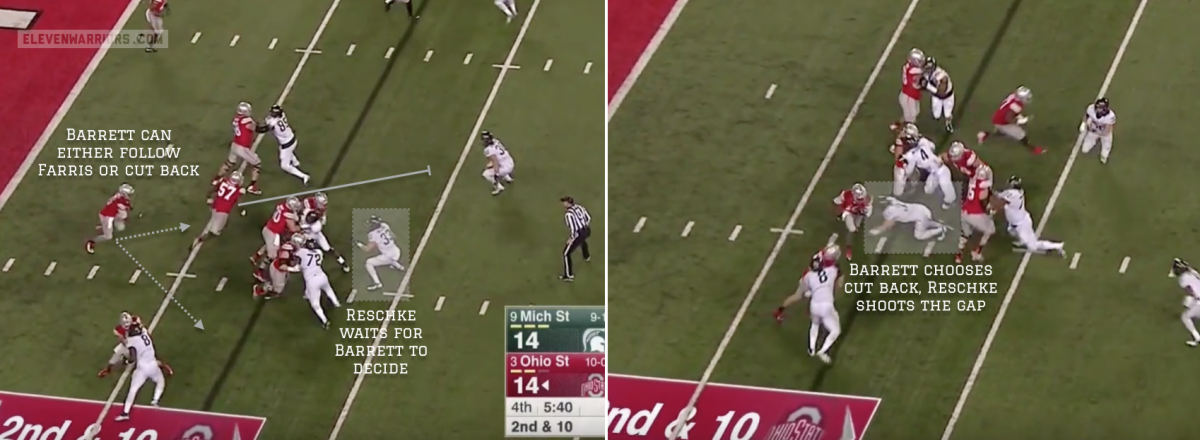
Their constant presence seemed to rattle Barrett, who made a number of uncharacteristically questionable decisions in both phases of the game. Though he had been known to make the correct read on option plays nearly every time, the sophomore signal-caller misread the defense on more than one occasion.
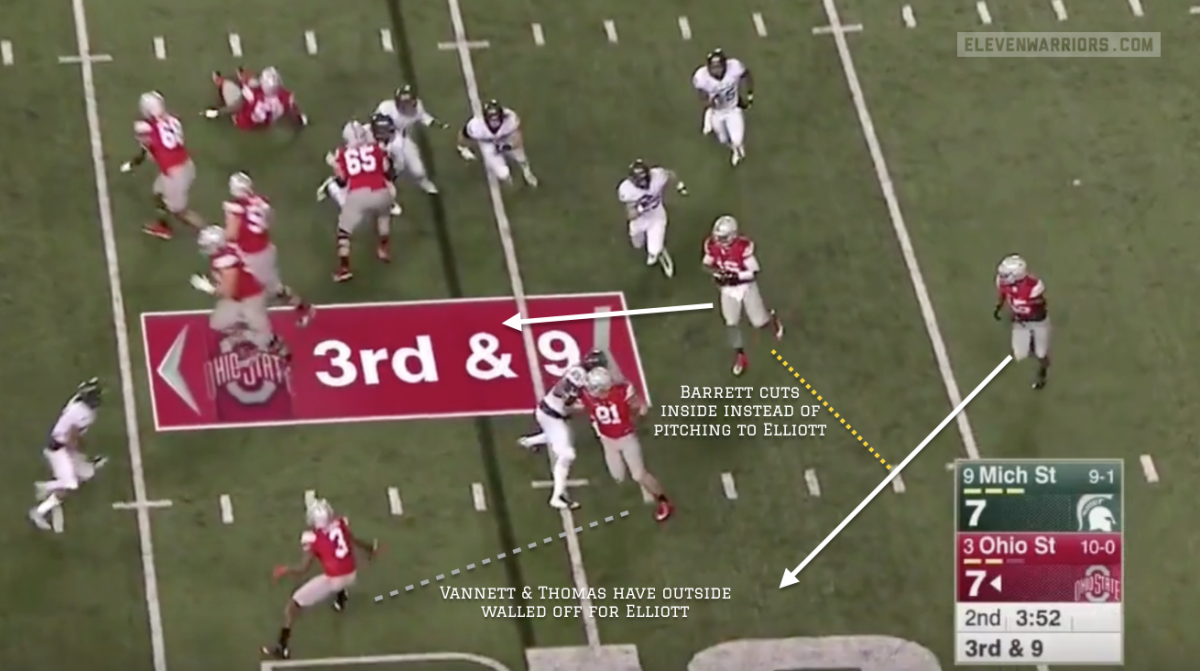
Barrett's hesitance to pull the trigger showed up in the passing game as well, as the QB tucked and ran on a number of occasions where he could have thrown to an open receiver downfield. This wasn't just when the rain really came down in the second and third quarters either, as he decided to try and pick up a 3rd-and-6 on the game's opening possession instead of throwing to either of two open receivers downfield.
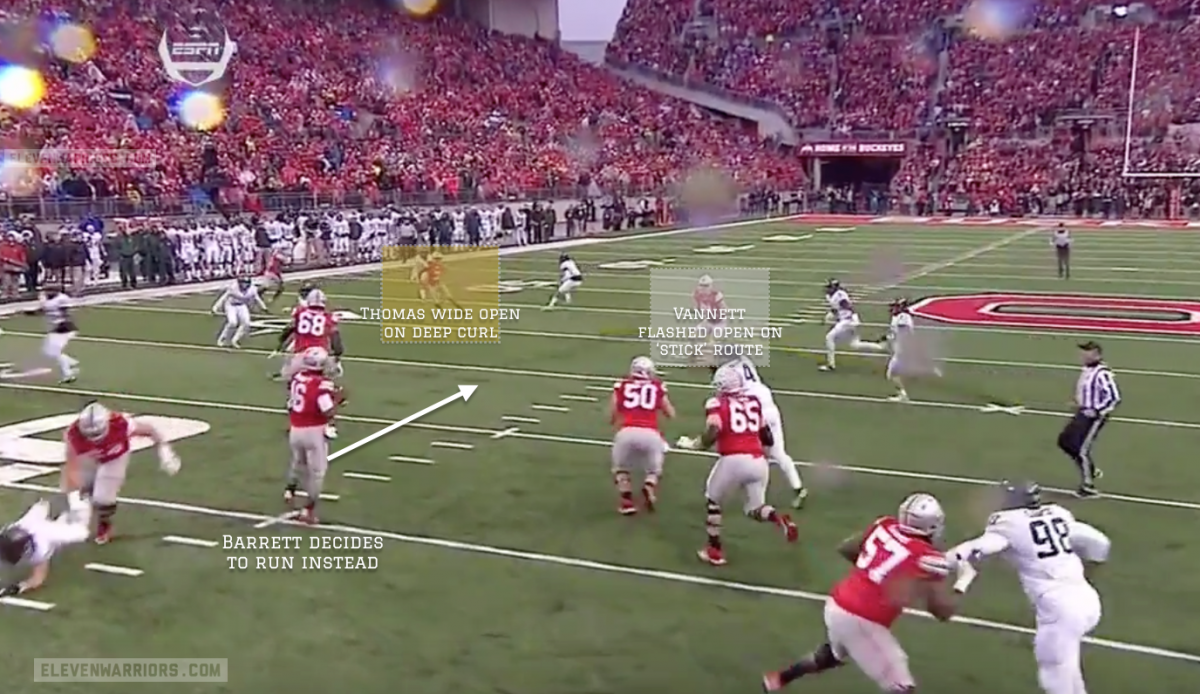
With Barrett's struggles apparent to anyone watching, it's understandable why the most talked about aspect of the play-calling was the lack of touches in the second half for running back Ezekiel Elliott. Yet some of the Buckeyes' biggest plays on the ground came when Elliott was acting as the lead-blocker, not carrying the ball himself.

By leaving the back-side end unblocked, the Buckeyes could gain a numerical advantage to the boundary with Elliott leading the way on this outside zone run. Yet even when put in the right position to take advantage of Michigan State's tendencies, the Buckeyes often failed to execute. When trying to run this same concept on another occasion, the play was blown up by MSU defensive tackle Craig Evans.

Lined up directly across from left guard Billy Price, Evans simply gets off his block and make an easy stop in the backfield. It appears as if Price is expecting center Jacoby Boren to pick up Evans on the inside, and simply lets him go as both blockers look upfield for a linebacker. Whatever the reason, the result was a negative play putting the OSU offense behind schedule with a long second down.
These kinds of breakdowns were far too common on this afternoon though. On the game's very first play, Price and Boren would be beaten thanks to the quickness of Malik McDowell (#4), who simply shoots the gap as neither player can get a hand on him before cutting down Elliott.

However the struggles up front weren't limited to Price and Boren. On another 3rd-and-3 in which Barrett's number would be called, Calhoun blows right by Decker on the left end before the tackle can get more than a hand on him. Meanwhile, right guard Pat Elflein isn't able to seal off his man, Damon Knox (#93), to the inside.

Given then short steps of the Buckeye offensive line to the left, this inside zone play should've given Barrett enough of an opening to stretch across the line for a first down before either linebacker could make a play. Instead, he is met in the backfield by a pair of defenders who just beat OSU's two most consistent blockers over the past two seasons.
With safeties clearly keying on any run action and a line that couldn't be depended on to make plays, it's no wonder that the OSU coaches stopped calling for inside runs with Elliott. The Buckeyes' star runner averaged 2.8 yards-per-carry on the day, the worst such performance over the past two years, through no fault of his own. Yet even though he may usually be the offense's best weapon, at a certain point the coaches couldn't keep calling plays that were clearly being stopped on that day.
These mistakes extended to pass protection as well, as Nick Vannett whiffed on his assignment on this long play-action pass to Braxton Miller that just narrowly missed.

Barrett had to release the ball with Vannett's blocking assignment closing hard to lay a big hit, leaving us all to wonder what might have been had the quarterback had more time to deliver a pass to his wide open receiver downfield.
The results speak for themselves though, as the worst offensive performance of Meyer's tenure can't be blamed on one particular person or concept. Everyone involved would probably like to have a decision or two back, which is normal for any unit.
Though new co-offensive coordinator Tim Beck seems to be receiving most of the blame for this performance, he was only a part of the play-calling triumvirate with Meyer and Ed Warinner. But any game plan only makes a difference if the players execute it properly, and on this day the Buckeye offense simply didn't.
Perhaps the upgrade in competition was more jarring than they expected, and the weather or senior day activities were a distraction. While this was certainly disappointing, it is not an indictment on the program as a whole. Being the team that executes better in 24 consecutive games is difficult, as Nick Saban's longest winning streak of 19 games at Alabama shows.
This is largely the same group that executed better than some of the country's best programs just one year ago, meaning the ability is there. While it's certainly disappointing that they weren't able to continue that streak of outplaying their opponents this week, my money remains on the offense that is 48-4 over the past four seasons when they face its biggest rivals in a few days.
